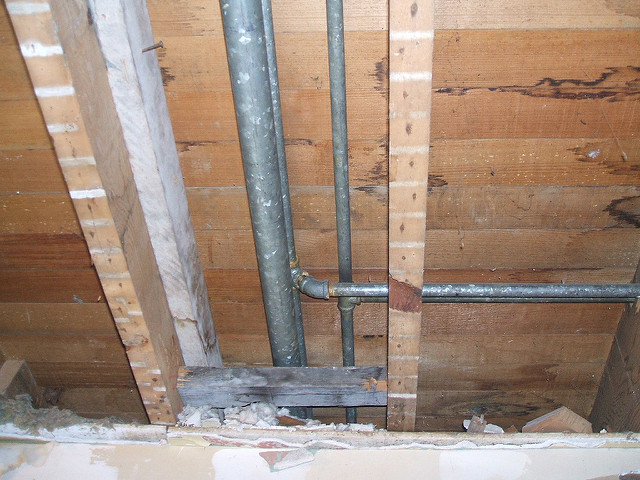How do you really feel with regards to Detecting hidden plumbing leaks?

Early detection of leaking water lines can reduce a prospective disaster. Some tiny water leaks might not be visible.
1. Take A Look At the Water Meter
Every house has a water meter. Examining it is a guaranteed way that helps you discover leakages. For starters, switch off all the water sources. Make certain nobody will certainly flush, utilize the faucet, shower, run the cleaning device or dish washer. From there, most likely to the meter and also watch if it will certainly transform. Because nobody is utilizing it, there need to be no motions. That suggests a fast-moving leak if it relocates. Likewise, if you identify no changes, wait an hour or two as well as inspect back again. This means you might have a slow leakage that can even be below ground.
2. Inspect Water Consumption
Assess your water bills as well as track your water usage. As the one paying it, you must observe if there are any discrepancies. If you find sudden changes, in spite of your usage being the same, it suggests that you have leakages in your plumbing system. Keep in mind, your water expense ought to fall under the very same array every month. An abrupt spike in your expense indicates a fast-moving leakage.
On the other hand, a steady increase on a monthly basis, despite having the exact same practices, reveals you have a sluggish leak that's additionally slowly escalating. Call a plumber to thoroughly check your residential or commercial property, specifically if you really feel a cozy area on your floor with piping underneath.
3. Do a Food Coloring Test
30% comes from toilets when it comes to water consumption. Test to see if they are running effectively. Decrease flecks of food color in the storage tank as well as wait 10 mins. There's a leakage between the storage tank as well as dish if the color in some way infiltrates your dish during that time without flushing.
4. Asses Outside Lines
Don't forget to check your exterior water lines too. Must water permeate out of the link, you have a loosened rubber gasket. One tiny leak can lose lots of water and surge your water costs.
5. Check and Assess the Situation
House owners ought to make it a behavior to check under the sink counters as well as even inside cupboards for any type of bad odor or mold development. These two red flags indicate a leak so prompt focus is needed. Doing regular assessments, also bi-annually, can conserve you from a significant trouble.
Check for stainings and also weakening as many pipes and appliances have a life span. If you believe dripping water lines in your plumbing system, do not wait for it to intensify.
Early discovery of leaking water lines can minimize a prospective calamity. Some little water leaks might not be noticeable. Inspecting it is a surefire method that aids you discover leaks. One tiny leakage can lose bunches of water as well as increase your water costs.
If you think dripping water lines in your plumbing system, do not wait for it to rise.
How to Know If Your Home Has a Hidden Leak
Water Meter Reveals Inexplicable Water Usage
If you’d like to test whether or not there’s a leak somewhere in your home, you can do this using your water meter. Here is how to conduct the test:
Don’t use any water in your home for at least 30 minutes; this also means not turning on faucets or water-using appliances.
Go outside, and check your water meter for activity.
If your water meter shows that there was activity, even though no one was using any water, this proves that there is a leak in your home.Visible Mold or Mildew Growth
Leaks behind walls create moist, dark environments that allow mold and mildew to grow and thrive. Eventually, you might see mold growth forming on the wall closest to a hidden leak.
If mold is growing in an area that receives a high amount of moisture, such as a bathroom, it may simply be an indication that better ventilation is needed. However, if you see mold growth on a wall or the ceiling in an area where you would not expect, you probably have a hidden leak.
Musty, Mildew Odor
Sometimes you might not be able to see the mold or mildew that is growing as a result of a leak. However, the smell can give the problem away just as easily. If you catch a whiff of something musty, there’s a good chance that old water is collecting somewhere in your home that you can’t see.
Stained/Warped Walls, Ceilings, or Floors
When your home soaks up water, a variety of red flags can become visible, including ceiling stains, bubbling drywall, warped walls, and sagging floors. While these issues can be caused by excess humidity, they can also be signs that a pipe or plumbing connection has started leaking behind your walls.
Inexplicably High Water Bill
After a while, you get a general sense for what your water bill should be. If you own a pool or sprinkler system, your bill will tend to be higher during summer. However, if you receive a water bill that seems especially high, and you can’t figure out what caused it, then you may have a hidden leak somewhere that’s increasing your bill.
https://www.plumbingjoint.com/blog/2019/july/how-to-know-if-your-home-has-a-hidden-leak/

Hopefully you enjoyed our post on Detecting hidden plumbing leaks. Thank you for spending some time to read through our post. Do you know somebody else who is occupied with the topic? Do not hesitate to share it. Kudos for your time. Don't hesitate to stop by our site back soon.